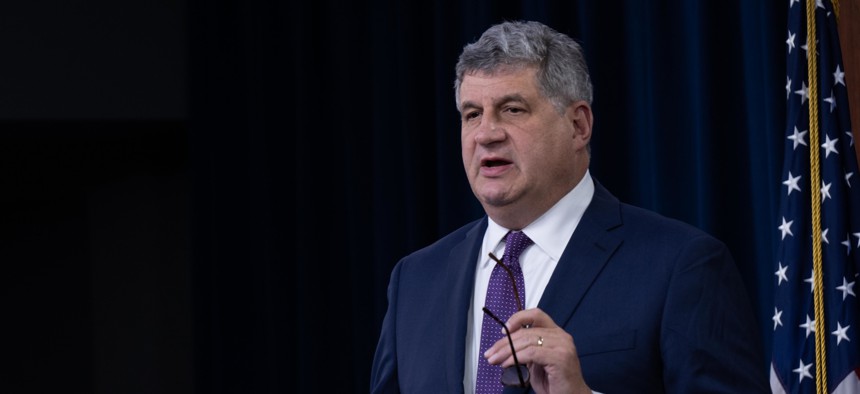
Under Secretary of Defense for Acquisition and Sustainment William LaPlante talks to reporters at the Pentagon on May 6, 2022. DoD / U.S. Navy Petty Officer 2nd Class James K. Lee
Don’t call it a slush fund: Pentagon’s top buyer says looser pursestrings will foster innovation
But some lawmakers and outside experts have their doubts.
The Pentagon wants Congress to ease up on budget limits so it can more freely buy technologies, like those used to take down drones, when it needs them. But the two organizations have some serious trust issues to untangle.
“We always have the same conversation, all of us collectively,” said Bill LaPlante, the Pentagon’s top weapons buyer, during a recent RAND event on the defense budgeting process. “What somebody looks at as ‘flexibilities’ is another person's ‘slush fund,’ or ‘unmonitored thing’. And that's why people choose all these words so carefully.”
The Pentagon’s decades-old buying system has long been criticized. Since 2022, a congressional commission has been working on recommendations for reforms of this planning, programming, budgeting, and execution, or PPBE, process.
One of the chief complaints about PPBE is the need to detail to Congress exactly what the Pentagon thinks it wants to buy years down the road—a method that doesn’t mesh well with the rapidly changing nature of computers and software-based tech.
The PPBE commission is expected to release its final report in March, with recommendations that could make things easier, but that’s not what the Pentagon is looking for.
LaPlante said he hopes the commission recommends “capability areas” instead of individual budget lines detailing how much to spend on specific systems.
“We’d love to have a counter-UAS capability area, not tell me exactly which system you're going to buy and how many of them, because what we would do today might not be what we have done four months ago, or four months from now,” he said. “Give us a counter-UAS capability and we'll buy the right ones as the threat changes. That simple thing, that would help us.”
But that’s unlikely, at least without some limits, Bob Hale, former Pentagon comptroller and chair of the PPBE commission, said during the panel.
“You're never gonna get that from the Congress, they're just not going to let you have that kind of flexibility. It won't happen. But you may get, if you presented the budget in that category, and then you agreed to some limits—no new starts without permission, or maybe, you know, there's some limited new starts,” Hale said.
LaPlante said it all comes down to trust.
“It's an issue of trust that, with the counter-UAS line…that we're not going to do bad things with that,” he said, adding that the Pentagon is working around it. “But if I'm the adversary, they are changing, every, almost every two weeks, their tactics, their jamming. It's that fast…So these are the real challenges that we have.”
Still, all the haranguing isn’t necessary, because DOD and Congress have what they need to buy better and faster, said Julia Gledhill, a defense analyst for the Project on Government Oversight.
“We significantly outspend both adversaries and allies on national security. The military needs to learn how to effectively spend what it already has—and it can’t do that when the focus is making taxpayer money as free flowing and flexible as possible,” Gledhill said via email.
Gledhill has acknowledged that some flexibility could help DOD adapt to changing threats, but “money isn’t the answer to every procurement challenge.”
“Military contractors can’t innovate when they’re spending their cash on payouts to shareholders,” she said. “And there’s no incentive to make that tradeoff when members of Congress and the PPBE commission promote giving contractors more money, faster.”


